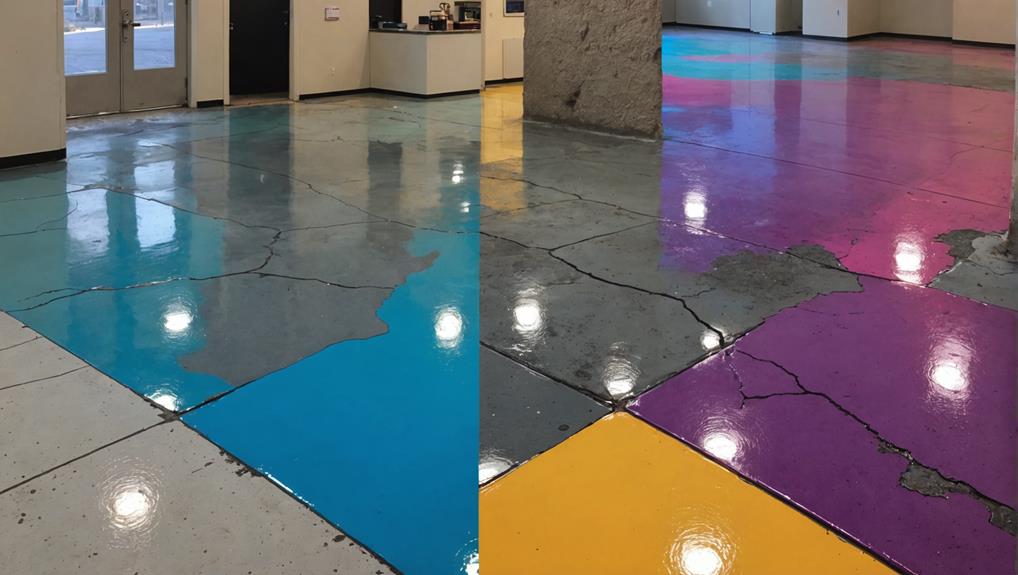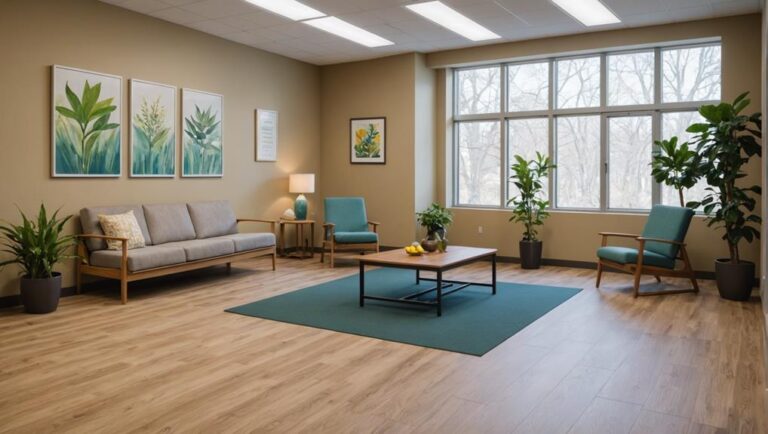Metallic epoxy flooring offers a striking visual appeal with its vibrant colors and unique patterns, making it a great choice for enhancing any space. You're looking at impressive durability, as it can withstand heavy foot traffic and resist chemical spills. Maintenance is straightforward, requiring only regular sweeping and occasional damp mopping. However, initial installation costs can be high, and installation requires careful temperature control to avoid issues. While slip resistance can be improved with textured finishes, ongoing inspections and resealing are necessary for safety. If you're curious about specific applications and longevity techniques, there's more to uncover.
Unique Aesthetic Appeal
One of the standout features of metallic epoxy flooring is its unique aesthetic appeal, which can transform any space into a visually striking environment. This flooring type utilizes a blend of metallic pigments, resins, and hardeners to create a dynamic surface that reflects light and enhances the overall ambiance. You'll appreciate the color variations available, ranging from vibrant blues and greens to more subdued metallic grays and silvers. These options allow you to tailor the flooring to your specific design preferences, making it an excellent choice for both residential and commercial spaces.
The design flexibility of metallic epoxy flooring is another key advantage. You can choose from various application techniques, such as swirls, marbling, or even custom patterns, allowing for a truly unique installation. This adaptability means it can fit seamlessly into various design themes, whether you're aiming for a modern, industrial look or a more traditional aesthetic. Additionally, the glossy finish not only enhances the visual appeal but can also make spaces feel larger and more open.
Furthermore, you should consider safety aspects, particularly when it comes to slip resistance. While metallic epoxy floors can be polished to a high shine, incorporating anti-slip additives during installation can help maintain safety without compromising aesthetics. This guarantees that your flooring not only looks stunning but also meets necessary safety standards, making it a practical choice for your environment.
High Durability
High durability is a hallmark of metallic epoxy flooring, making it an ideal choice for high-traffic areas in both residential and commercial settings. This flooring type boasts exceptional impact resistance, meaning it can withstand heavy foot traffic, dropped items, and even vehicles without showing significant wear. Additionally, its chemical resistance helps protect against spills and stains, ensuring that your floor remains intact and visually appealing over time.
Here's a brief comparison of metallic epoxy flooring's durability features:
| Feature | Description |
|---|---|
| Impact Resistance | Withstands heavy impacts without chipping or cracking. |
| Chemical Resistance | Resists damage from various chemicals and spills, promoting safety and longevity. |
| UV Stability | Maintains color and finish even under direct sunlight. |
The combination of these features makes metallic epoxy flooring an excellent investment for spaces that require both aesthetic appeal and robust performance. Safety is paramount, particularly in industrial or commercial environments where chemicals may be present. By choosing metallic epoxy, you're ensuring that your flooring can handle the rigors of daily use while minimizing hazards associated with slips or stains.
Easy Maintenance
Maintaining metallic epoxy flooring is a straightforward process that saves you time and effort, allowing you to focus on other important tasks. One of the standout features of this flooring type is its resistance to stains and spills, which greatly reduces the frequency of deep cleaning required. For daily upkeep, simple cleaning techniques, such as sweeping or using a dust mop, can prevent dirt and debris from accumulating. A damp mop with a pH-neutral cleaner will effectively remove any remaining residue without compromising the floor's finish.
Routine inspections play an essential role in ensuring your flooring remains in top condition. During these checks, look for any signs of wear or damage, including cracks or peeling, which can occur over time. Addressing these issues promptly can prevent further deterioration and maintain the aesthetic appeal of your metallic epoxy flooring.
Additionally, you'll want to avoid abrasive cleaners or scrubbing pads, as they can scratch the surface and diminish its shine. Instead, opt for soft cloths or microfiber mops that are gentle yet effective. While metallic epoxy flooring is designed to withstand heavy foot traffic and various environmental factors, regular maintenance will keep it looking pristine.
Cost Considerations
When considering metallic epoxy flooring, it is crucial to evaluate the initial installation expenses, which can be higher than traditional options. Additionally, you'll want to account for long-term maintenance costs and how well the flooring retains its value over time. Understanding these financial factors will help you make an informed decision that aligns with your budget and expectations.
Initial Installation Expenses
Understanding the initial installation expenses of metallic epoxy flooring is important for any property owner considering this option. The costs can vary considerably based on several factors, including the size of the area and the complexity of the design. One key aspect is installation time; more intricate patterns or colors typically require longer application periods, thereby increasing labor costs.
Labor costs can constitute a considerable portion of your overall investment. Hiring experienced professionals adept in metallic epoxy application is essential for ensuring a safe and durable finish. While you might encounter lower bids, remember that quality workmanship is important for the longevity and safety of your flooring.
Additionally, the preparation process can add to your expenses. Proper surface preparation is crucial to prevent issues such as delamination or cracking, which could compromise safety. This stage may involve cleaning, grinding, or repairing the substrate, all of which can increase both installation time and labor costs.
Long-Term Maintenance Costs
After considering initial installation expenses, it's important to factor in long-term maintenance costs associated with metallic epoxy flooring. While this type of flooring is known for its durability and aesthetic appeal, it does require specific care to maintain its integrity and appearance over time.
Regular maintenance can help prevent costly repairs later. Here are some key considerations:
- Cleaning Products: Use pH-neutral cleaners to avoid damaging the epoxy surface. Harsh chemicals can wear down the finish.
- Repair Techniques: Familiarize yourself with effective repair techniques for minor scratches or chips. Quick fixes can extend the life of your flooring.
- Routine Inspections: Conduct regular inspections to identify potential issues early. Catching problems before they escalate can save you money.
- Sealing: Depending on traffic and wear, resealing may be necessary every few years to maintain the floor's protective layer.
Value Retention Potential
Evaluating the value retention potential of metallic epoxy flooring can considerably impact your long-term investment decisions. This type of flooring not only enhances aesthetic appeal but also offers significant value appreciation over time. When considering resale potential, it's vital to weigh the initial installation costs against the likelihood of increasing property value.
| Factor | Impact on Value Appreciation | Resale Potential |
|---|---|---|
| Initial Cost | Moderate | High |
| Durability | High | High |
| Aesthetic Appeal | High | Moderate to High |
| Maintenance Expense | Low | High |
Investing in metallic epoxy flooring typically leads to lower maintenance expenses, which can safeguard your overall investment. Its durability guarantees that the flooring remains in excellent condition, appealing to future buyers. Additionally, the unique aesthetic can set your property apart, potentially commanding a higher price on the market. As a result, understanding the value retention potential of metallic epoxy flooring is significant in making an informed decision that prioritizes both safety and financial return.
Installation Process
When you're ready to install metallic epoxy flooring, the process involves several vital steps to guarantee a durable and visually appealing finish. First, preparation is key—make sure the surface is clean, dry, and free of any contaminants. This step is essential for a successful bond.
Next, you'll want to focus on the application techniques. Using a combination of rolling and troweling will help distribute the epoxy evenly, enhancing both its aesthetic and performance. Pay close attention to the manufacturer's guidelines regarding mixing ratios and application methods.
Once you've applied the base layer, the curing times will dictate your next steps. Typically, you'll need to allow the epoxy to cure for at least 24 hours before applying any additional layers. This is vital for achieving the desired durability and finish.
Here's a quick checklist to keep in mind during the installation process:
- Ensure proper surface preparation—clean and dry.
- Utilize suitable application techniques for even coverage.
- Monitor curing times to avoid premature foot traffic.
- Consider safety gear, including gloves and masks, during installation.
Temperature Sensitivity
Temperature plays a significant role in the curing and overall performance of metallic epoxy flooring. If you're considering this type of flooring, it's vital to understand how temperature sensitivity can impact its integrity. Epoxy resins require specific temperature ranges for ideal curing. Typically, a temperature between 60°F and 90°F is perfect. Curing at temperatures outside this range can lead to incomplete hardening, compromising durability.
Moreover, temperature fluctuations can cause thermal expansion and contraction in the epoxy material. If the floor experiences significant changes in temperature, it may result in cracking or bubbling. This is particularly important in environments subject to extreme heat or cold, where rapid temperature shifts can be common. For instance, if your space is heated during winter and left unheated during warmer months, the epoxy may not be able to adjust without damage.
To guarantee safety and longevity, it's advisable to maintain a consistent temperature during both installation and curing. Monitoring temperature can help you mitigate risks associated with thermal expansion. If you're working in an area prone to temperature fluctuations, consider consulting with a professional to select the right materials and techniques that can withstand these conditions.
Slip Resistance
When considering metallic epoxy flooring, understanding slip resistance is essential for safety. The surface texture greatly impacts traction, and regular maintenance can enhance or diminish its effectiveness. By evaluating these factors, you can guarantee a safe environment while benefiting from the aesthetic appeal of metallic finishes.
Surface Texture Impact
Although the aesthetic appeal of metallic epoxy flooring is often highlighted, its surface texture plays a vital role in determining slip resistance. Understanding how different texture finishes can enhance safety in your space is important, especially if you're weighing this option for high-traffic or wet areas.
Here are some important aspects to take into account regarding texture and slip resistance:
- Surface Finish: A matte or textured finish can greatly improve grip compared to a glossy surface, which can become slippery when wet.
- Color Variations: Using darker color variations may help in hiding dirt and debris, but it's important to verify that the chosen color doesn't compromise visibility on the floor.
- Custom Options: Some manufacturers offer customizable texture finishes, allowing you to select a profile that meets your safety needs while still achieving your desired look.
- Safety Ratings: Always check the slip resistance ratings for the specific metallic epoxy flooring you're weighing, as different formulations can yield varying levels of traction.
Maintenance and Safety
Maintaining metallic epoxy flooring is essential for ensuring both its aesthetic appeal and safety, particularly regarding slip resistance. A well-maintained surface reduces the risk of slips, which is vital in high-traffic areas. Regular cleaning and inspection can help you identify potential hazards before they become serious issues.
Here's a quick reference table to assist you in maintaining slip resistance:
| Maintenance Task | Frequency |
|---|---|
| Regular Cleaning | Daily |
| Inspect for Damage | Monthly |
| Reseal if Needed | Every 1-3 years |
| Check for Chemical Spills | As needed |
Metallic epoxy floors offer excellent chemical resistance, making them ideal for environments where spills are common. However, these spills can lead to slippery conditions if not promptly addressed. Additionally, in settings where fire safety is a concern, metallic epoxy flooring can enhance safety by providing a durable, non-combustible surface.
Frequently Asked Questions
How Does Metallic Epoxy Flooring Compare to Traditional Flooring Options?
When you compare metallic epoxy flooring to traditional options, you'll notice significant differences in design aesthetics and maintenance requirements. Metallic epoxy offers a unique, glossy finish that can enhance your space's visual appeal, unlike more standard flooring types. However, it generally requires less ongoing maintenance, as it's resistant to stains and easy to clean. Traditional flooring might need more frequent upkeep, making metallic epoxy a practical choice for safety-conscious environments seeking durability and style.
Can Metallic Epoxy Be Applied Over Existing Flooring Materials?
Yes, metallic epoxy can be applied over existing flooring materials, but proper surface preparation is essential. You'll need to guarantee the old surface is clean, dry, and structurally sound. Installation techniques vary based on the substrate, so you may need to grind or sand the surface to promote adhesion. Always follow safety guidelines during preparation and application to avoid any hazards, guaranteeing a durable and aesthetically pleasing finish for your space.
What Is the Lifespan of Metallic Epoxy Flooring?
The lifespan of metallic epoxy flooring typically ranges from 10 to 20 years, depending on the installation process and maintenance requirements. If installed correctly, this flooring can withstand heavy foot traffic and resist stains. Regular cleaning and periodic resealing can enhance its longevity. You should make certain that you follow the manufacturer's guidelines for maintenance to maximize durability and safety, preventing potential hazards from wear and tear over time.
Are There Environmental Concerns With Metallic Epoxy Flooring Materials?
When you think of a shimmering pool of molten metal, it's easy to be captivated. However, concerning metallic epoxy flooring, there're environmental concerns to contemplate. You should be aware of the sustainability impact, as many products contain volatile organic compounds (VOCs) that can emit harmful fumes during application and curing. Ensuring proper ventilation and selecting low-VOC options can help mitigate these risks, allowing you to enjoy a beautiful floor while prioritizing safety.
How Does the Curing Time of Metallic Epoxy Affect Installation?
The curing time of metallic epoxy greatly impacts installation efficiency. During the curing process, the epoxy hardens, determining how quickly you can apply additional layers or finish the project. If the cure time is too long, it can delay your timeline and affect safety, as working on uncured surfaces can lead to slips or damage. Properly managing the curing time guarantees a durable, safe floor while maximizing your installation efficiency.




